Step By Step Guide On Options Trading in India 2024: Indicators, Strategies
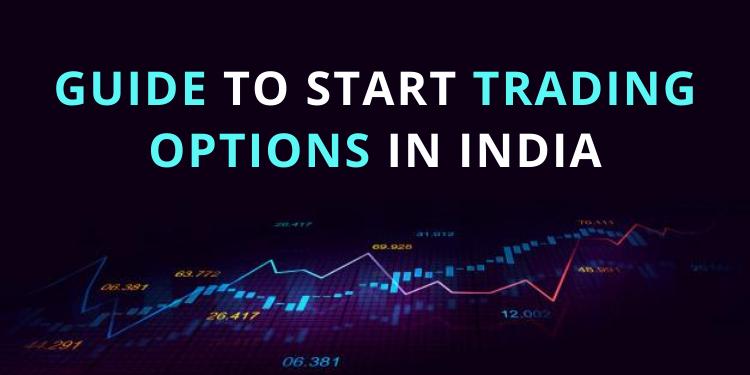
Step By Step Guide On Options Trading in India 2024: Indicators, Strategies

Options Trading is a form of contract that gives you the right, to either buy or sell an amount of stock at a pre-determined price. But you are not obliged to buy or sell the stock.
Let’s understand option trading in India with an example.
Shyam is looking to buy a Rs. 30 Lakh flat from Ravi on the outskirts of the city. There is a likelihood of a mall coming up in the next five months which will drive the real estate price higher to Rs. 40 Lakhs.
But, if it wouldn’t happen then the real estate market price may come down to Rs. 25 Lakh.
Shyam wants to buy the flat but does not want to pay more. Ravi gives Shyam an option (the right) to buy the flat at Rs. 30 Lakh (strike price) if he pays an upfront fee of Rs. 1 Lakh for a period of five months.
Shyam gets the right to buy or not to buy the flat within a period of five months and Ravi is bound by the contract to sell it only to Shyam.
If the mall comes up and the flat prices increase to Rs. 40 Lakhs, then Shyam benefits by exercising the right. In case the price falls to Rs. 25 Lakhs then Shyam will not exercise the rights. But he loses only the upfront money.
The upfront money is called premium in case of Options trading and the contract price at which you are ready to buy the underlying security is called the ‘Strike’ price. In the case of real estate, the strike price was 30 lakh.
You can buy any underlying instrument such as stock, commodities, index, or forex for option trading in India.
The upfront fees that you pay for buying an option contract is called the ‘Premium’ and
- What is Option Trading
- How Option Trading Works in India
- Types of Option Trading
- Best Indicators for Intraday Option Trading in India
- Best Strategy for Options Trading in India
- How to do Option Trading in India
- How to do Bank Nifty Intraday Option Trading in India
- Option Trading Tips in India
- Final Words
What is Option Trading
Options trading is when you buy/ sell an options contract on a recognized stock exchange with the help of the online trading platform provided by your stockbroker.
Options trading is also known as derivatives trading because the options contracts derive its value from the underlying instruments.
Buying an option that gives you the right to buy shares before the expiry date is called a Call option.
Whereas buying an option that gives you the right to sell shares before the expiry date is called a Put option.
Trading in options does not mean that you have to actually exercise the right at the buy/sell point. In day trading options you simply buy/sell options without worrying about exercising the rights.
Options give you the power to buy a higher number of shares for a small amount of money (called premium) in comparison to buying a stock.
For example, you can buy 1 call option contract of Reliance by paying Rs. 72.50 for a particular strike price that has 505 underlying Reliance shares.
A reliance call option with a strike price of Rs. 1900 gives you the right to purchase 505 Reliance shares at Rs. 1900 irrespective of the current stock price. You need Rs 1,35,340 to buy an option for 505 shares.
You would need around Rs 959500 (1900* 505) to directly buy 505 reliance shares.
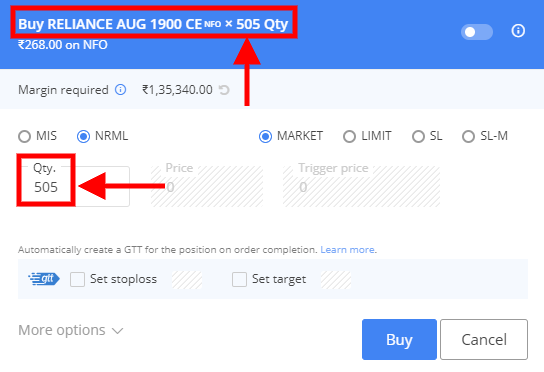
How Option Trading Works in India
#1. You Need an Options Trading Account
To trade options you need to have a trading account with any of the top stockbrokers like Zerodha, or Upstox.
Options contracts are cash-settled and there is no delivery of underlying instruments. That means you do not require a Demat account. A trading account linked with your bank account is sufficient to trade-in options.
Trading in options is done in lots. A single lot size contains a fixed number of underlying instruments. For example, 1 lot of Infosys call or put options has 1200 number of underlying Infosys shares.
Full-service stockbrokers charge Rs. 50 to Rs. 100 per lot for trading options. Whereas, discount brokers charge a low flat Rs. 20 per lot for trading options.
You need the following documents to open an options trading account
- Aadhaar Card
- PAN Card
- Canceled Cheque showing IFSC or MICR Code
- Salary Slip, IT Return or Form -16 (for F&O segment)
You need to choose F&O (derivatives) while account opening. I would suggest you open a Zerodha account.
- Fix Rs. 20 per trade on intraday trades
- Zero brokerage on the stock delivery
- Good customer support
- Best charts and tools for technical analysis
#2. Need Margin Money
Option trading involves a higher amount of risks due to the large number of underlying instruments and volatility.
For buying options contracts you may need a small amount that is equal to the premium amount multiplied by the underlying contract value.
For example, to buy 1 lot of Bank Nifty Call options (that has an underlying value of 25) and currently premium trading at Rs. 700, you need to have Rs. 700 x 25 = Rs. 17,500 cash in your account.
But, for selling options contracts there are exchange stipulated margins requirements based on the volatility of the underlying instruments that are higher in comparison to buying options.
In general, you need to keep at least Rs. 1.5 Lakhs to Rs. 2 Lakhs of funds in your trading account depending on your trading requirements.
#3. Find Liquid Options for Trading
There are at least 15-20 call options available on a particular stock. For example, the Asian Paints stock shows the following call options contract with different strike prices.
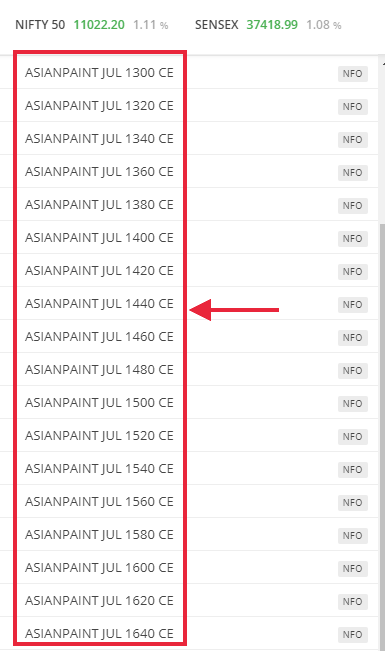
And an equal number of Put options are available for trading. For trading options, you need to have the most liquid options contract so that you can buy/sell at any moment.
Generally, the options having strike price near to the current stock price is the most liquid.
However, to select the most liquid options for trading intraday you can take the help of NSE India or MoneyControl who list the details of most active option contracts.
NSE India list of the most active call option details.
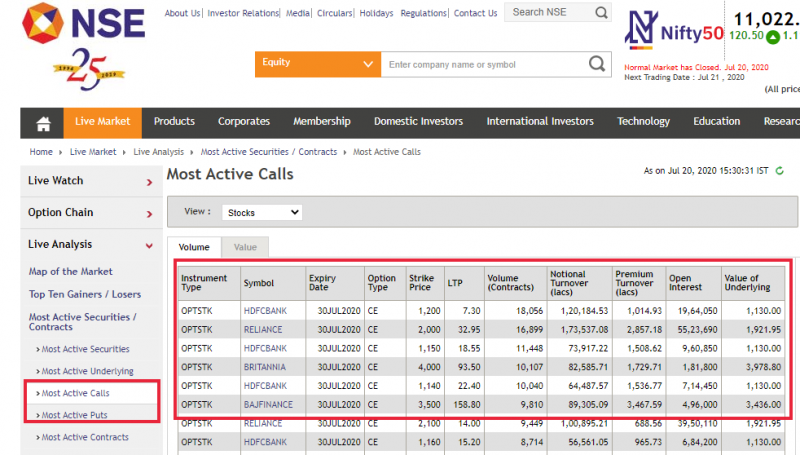
MoneyControl list of the most active call option details.
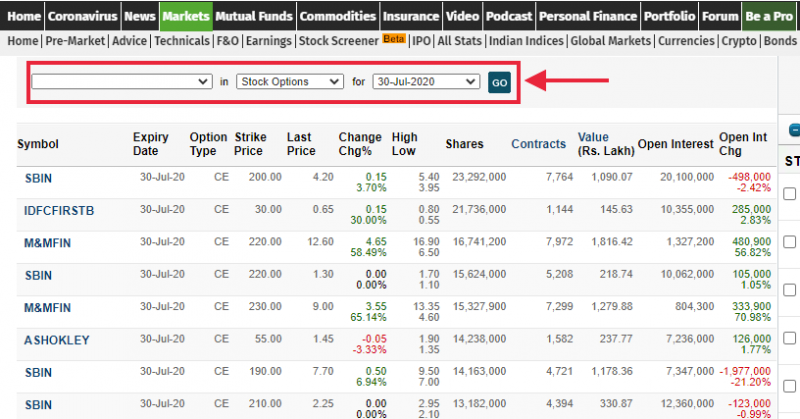
Types of Option Trading
You can do either day trading or positional trading in options depending on your trading strategy.
#1. Options Day Trading
Options Day trading involves buying/ selling a particular option contract, similar to day trading of stocks. You need to have a view of the particular stock and trade as per the price action.
You have charting tools and indicators to help you do technical analysis and trade as per your strategies.
For example, you may pick the most liquid option contract like SBIN JUL 200 CE and then based on your view you can buy/sell or sell/buy multiple times.
Your overall profit/ loss will depend on the movement of the option price and the number of trades that you have closed in profit.
In the starting learning phase, try to win more trades with small profits rather than target big profits. For example, if you are putting Rs 1 lakh in options trading then target Rs 1000 daily profit from the stocks through options trading.
#2. Options Position Trading
Positional trading in options involves buying/ selling of multiple options to form an option strategy such that you have positive cash flows until the options are held.
The option positions are built after taking a view on the particular index or stock. Here multiple options are used to restrict the loss.
For example, if you are bullish on the Bank Nifty and expect a moderate rise in the price, then you can take the Bull Call Spread position (strategy).
For a Bull Call Spread, you need to
- Buy Bank Nifty calls at a specific strike price (let say Bank Nifty JUL 22100 CE, and
- Sell the same number of calls that have a higher strike price (Bank Nifty JUL 22200 CE)
With a bull call position, you are locking your upside (profits) and downside (losses) till you hold the position.
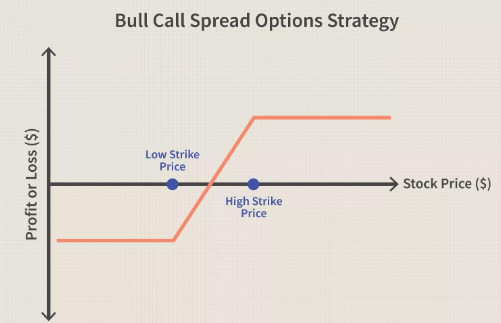
The maximum profit per lot is the difference between the strike prices of the two call options minus the net option premium paid = 22200-22100-(the net premium paid).
The maximum that you will lose is the entire premium that you have paid while buying the call. Here you need to make sure that both the call options should have the same expiry.
Building such option positions and strategies takes time and calculation work that may be hard for you at the beginning.
Best Indicators for Intraday Option Trading in India
#1. Open Interest (OI)
Open interest is the number of unsettled or open contracts of a particular option. OI does not indicate downtrend or uptrend, but you get fair indications about the strength of a particular trend.
Increasing open interest indicates fresh buying or rising interest in that particular option contract and sustainability of the existing trend. Whereas, a declining OI indicates a weakening of the existing trend.
| Price | Open Interest | Interpretation |
| Rising | Rising | Market/ stock is going strong |
| Rising | Falling | Market/ stock is getting weak |
| Falling | Rising | Market/ stock is getting weak |
| Falling | Falling | Market/ stock is going strong |
#2. Put-Call Ratio (PCR) Indicator
The put-call ratio measures the trading volume of put options vs call options. The changes in the put-call ratio help in understanding the sentiments.
When there are more puts than calls, i.e. when the PCR ratio is above 1, then it indicates that more traders/ investors in that option are getting bearish.
Similarly, when the call volume is higher than put volume making the PCR ratio less than 1, then you have more bullish participants.
However, you should not rely solely on the PCR indicator because hedge fund managers often buy put options contracts to hedge their portfolio. In such a scenario the PCR ratio will be above 1 indicating a bearish market, which may not be the actual case.
#3. Intraday Momentum Index (IMI)
The Intraday Momentum Index is helpful for high-frequency option traders looking to trade aggressively on intraday option price movements.
IMI combines the candlestick analysis along with the RSI (Relative Strength Index) to provide insights for intraday trading. You get to know when the option is overbought or oversold.
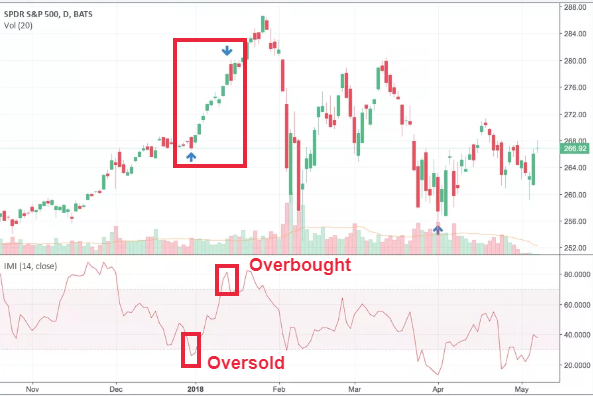
IMI indicator levels over 70 indicate overbought conditions ripe enough to initiate a sell trade. Whereas, IMI levels below 30 indicate oversold conditions where you can enter a long trade.
However, when the prices are in uptrend or downtrend then the indicator will constantly indicate overbought or oversold conditions.
#4. Relative Strength Index (RSI)
The Relative Strength Index is a plain momentum indicator that helps you determine the overbought and oversold conditions.
RSI compares the magnitude of recent gains to recent losses. RSI values also range from 0-100.
RSI works best for options on individual stocks, as compared to indexes because stocks reflect overbought and oversold conditions more frequently than indexes.
You can enter a short call or a long put trade when the RSI shows a value above 70 (overbought conditions). When the RSI is below 30 (oversold conditions) you can buy a call or sell a put option.
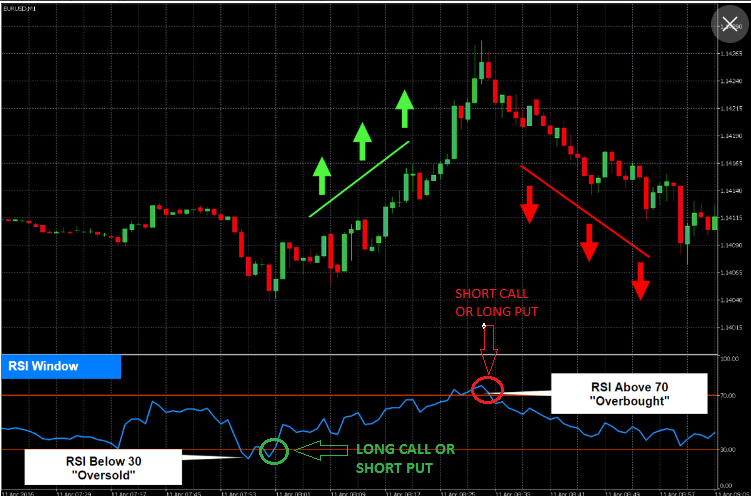
Best Strategy for Options Trading in India
Bollinger Band Strategy
The Bollinger Band is made up of a set of three lines where the middle line is the simple moving average of the last 20 candles’ price.
The upper and lower lines form the band on either side of the middle line. The upper and lower bands are 2X standard deviations from the middle line and indicate the overbought and the oversold zone.
The Strategy
When the price moves outside of the bands, then the option is ready for a potential reversal. So, if the breakout is above the top band, you may initiate a long put or a short call position.
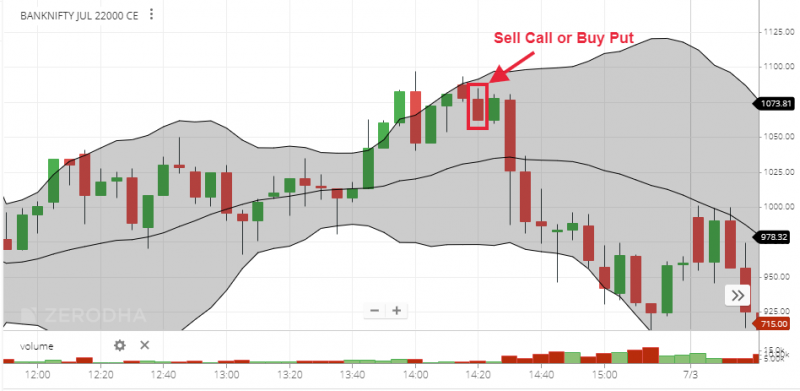
You can sell calls when the red candles re-enter the upper band and tend to move lower as shown in the chart above.
When the breakout is from below the lower band you may take a long call or short put as shown in the chart below.
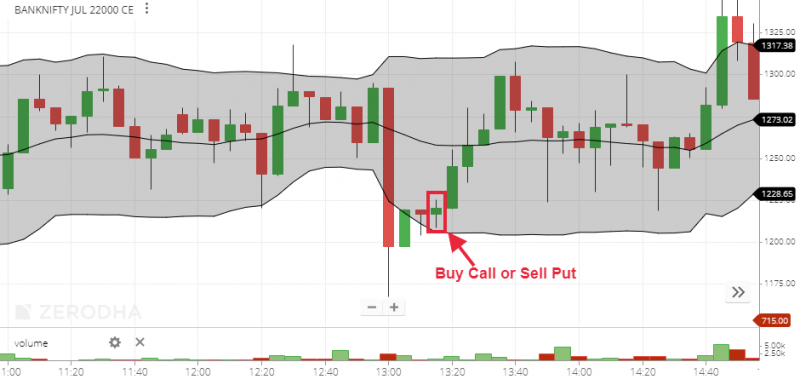
Note – That the above strategy does not work when the prices are moving upward (up-trend) or downward (down-trend) sharply. You need to wait until the trend gets over.
There are hundreds of positional strategies that can be built on options based on your views.
The platform is dedicated to options trading and helps in quickly creating strategies just by entering your views on the option you want to trade.
How to do Option Trading in India
Step 1 – Login to Trading Platform
Login into your online trading account using the ID and password provided by your stockbroker. If you don’t have an account, you can open the Zerodha account from here.
After you have logged in you will get the dashboard as shown below.

- Fix Rs. 20 per trade on intraday trades
- Zero brokerage on the stock delivery
- Good customer support
- Best charts and tools for technical analysis
Step 2 – Add Funds
For trading in options, you need to have at least Rs. 1.5 Lakhs to Rs. 2 Lakhs in your account. Use the Add Funds/ Withdraw option if you have insufficient funds for options trading.
When you click the “Add Funds” option then you will get a pop-up window where you need to add the amount, select the segment (common segment for equity/ derivatives and currency).
Check the prefilled bank account details and select the payment mode (UPI or net banking). You will be directed to the bank/ payment portal where you can complete the online fund’s transfer process.
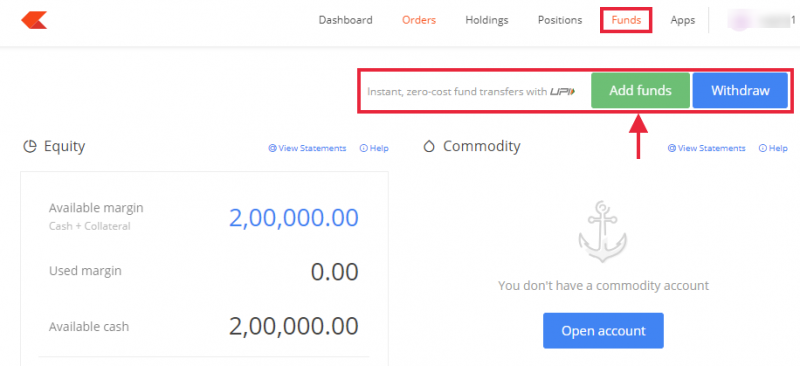
Step 3 – Create Watchlist
Find the most liquid options that you want to trade using the NSE India or MoneyControl website as mentioned earlier.
Next, you need to create a watchlist where you can keep track of the option that you have selected for day trading.
On the left-hand top, you have the search option, where you can type the option name. For example, you can type BHEL JUL 45 for the stock option of BHEL shares.
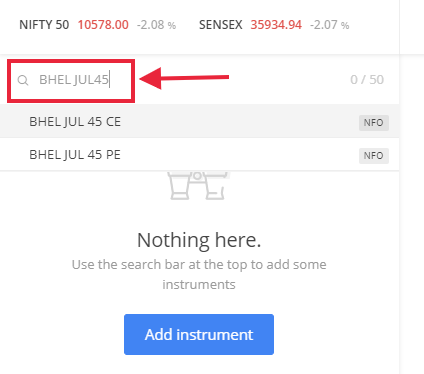
Immediately you will get the options with the specified strike price (45). Select the option in which you want to trade and click on the “Add instrument” or (+) tab as shown below
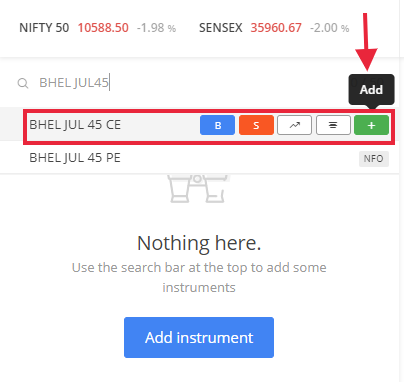
Step 4 – Place an Option Buy Order
Click on the market depth tab and you will get the live BID and ASK quotes and the trade details.
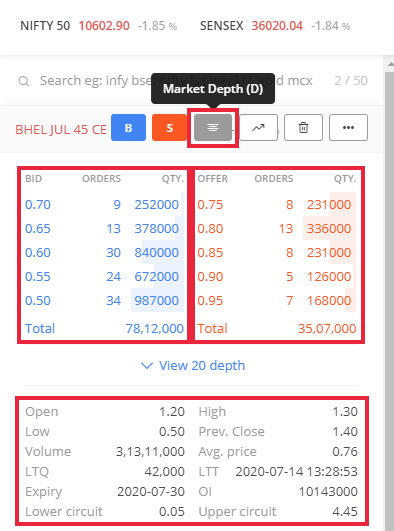
The left-hand side prices in blue are the buyers with the call premium prices indicated and the right hand are the sellers with the indicative call premium prices.
To buy a call option for intraday trading click on the blue (B) button and to sell click on the orange (S) button.
When you click the buy tab you will get a pop-up window as shown below.
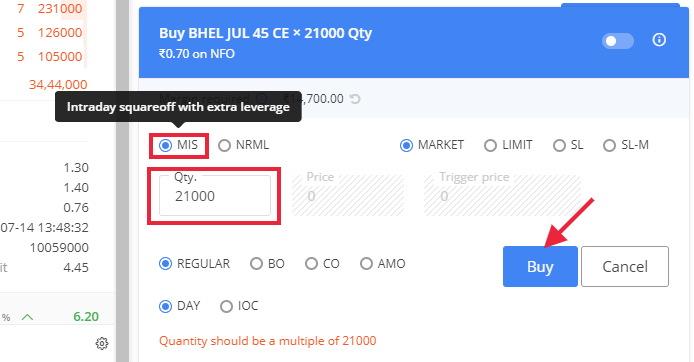
Select the MIS radio button for intraday trading. Adjust the quantity and choose the market option to buy the option at market price.
You can also place limit orders or stop-loss orders depending on your trading style.
After the order is placed you can check the status of the order on the order book page.

Step 5 – To Square Off
Click open the “Positions book” where you will get the profit/ loss details of that option contract that you have purchased.

To square off check the square tab so that the “tick sign” is visible and “Exit position” pops up. Click on the “Exit position” tab to close your existing option contract.

Step 6 – To Sell Options
You need to select the sell tab as shown in the image below.
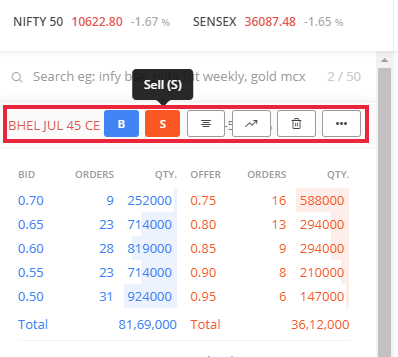
On the order form select the MIS for intraday trading and fill in the quantity and the limit price at which you want to place an order. Click on the “Sell” tab to place the order.
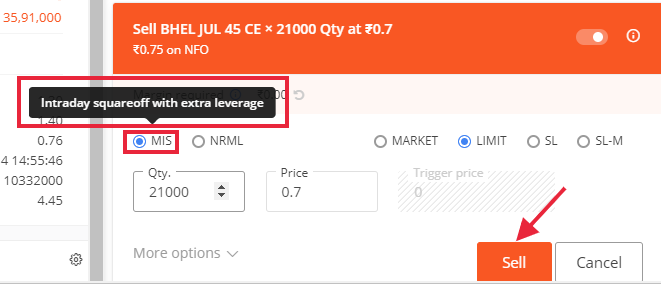
Then you can check the order book and the positions book for the status of the option sold. To square off, you need to follow the same process as mentioned for Square off.
How to do Bank Nifty Intraday Option Trading in India
#1. Choose the Most Liquid Bank Nifty Option
Take the help of the NSE or any other website like moneycontrol to find the most liquid Bank Nifty option contract.
You can do this by selecting the option “Most active contracts”, which will list down the list of option contracts with high volume.
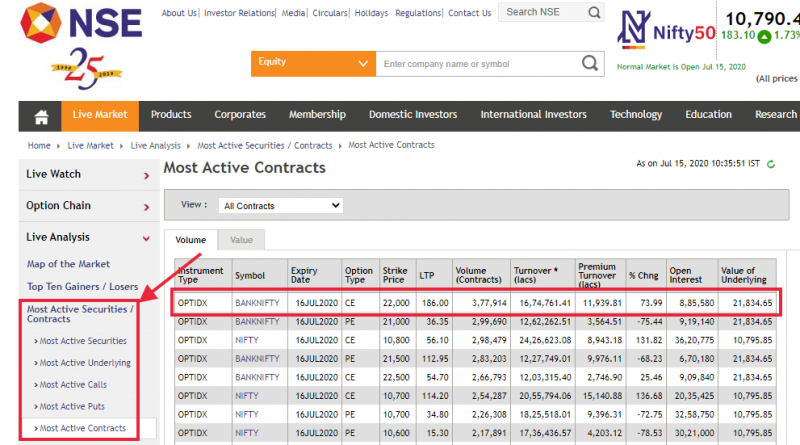
#2. Check the Contracts Market Depth
Now on the trading platform search for the selected Bank Nifty contract and add it to the watchlist.
Click open the market depth details, where you will come to know about the latest buy/sell quotes. For liquid options contracts, the price movements will be fast blinking.
You can also check the open, high, low and close price and the volume details below.
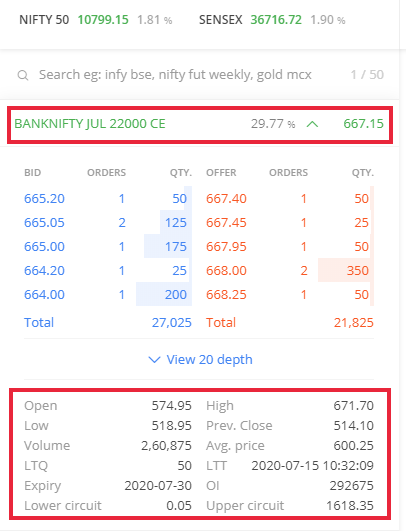
#3. Bank Nifty Option Sell Trade
Have a view on the Bank Nifty index before you trade and then form a suitable strategy. Suppose you have a view that the Bank Nifty will go down then you can
- Sell Bank Nifty Call option, or
- Buy Bank Nifty Put option
Click on the Sell tab and fill up the quantity and price in the order form and click the “Sell” tab.
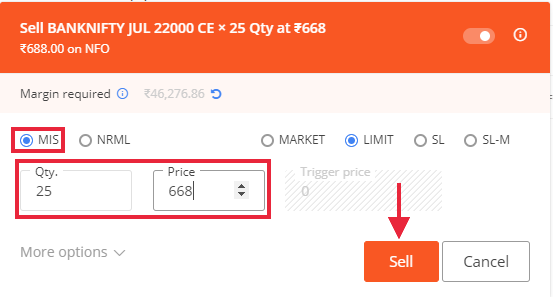
The know the status of whether the order is open or complete, you can view from the order book page as shown below.
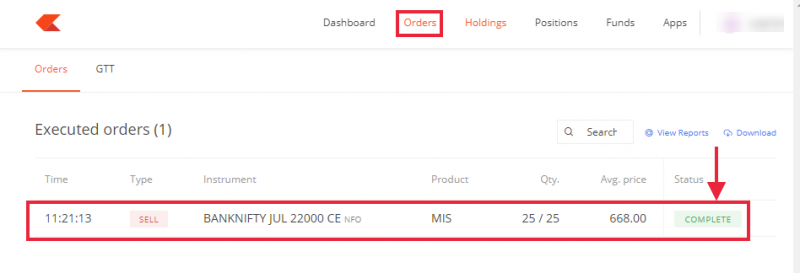
To square off the trade, you need to select the box “the blue tick” symbol appears when the instrument gets selected. Then you need to click on the blue “exit position” tab.

Note – While squaring off the trade the window does not let you set the price, but you need to close the position at market price.
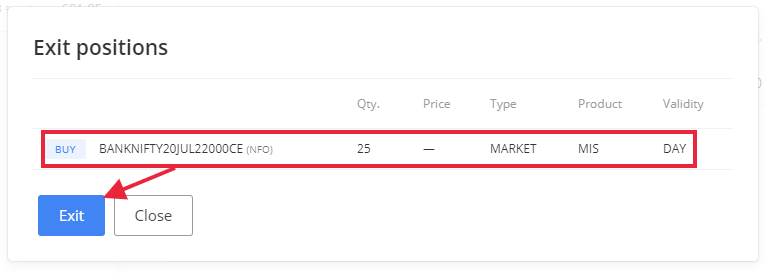
#4. Buy Bank Nifty Put Option
With the same view, you can even buy Bank Nifty Put Options. Click on the “Buy” tab after you have entered the details like price and quantity.
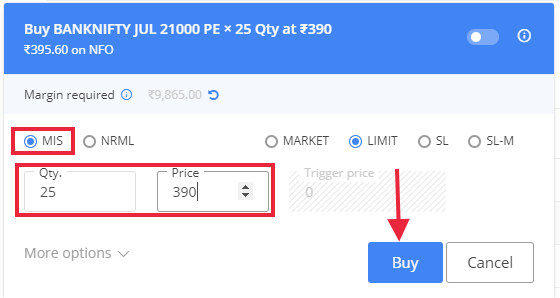
You can check the position of the trade on the position page.
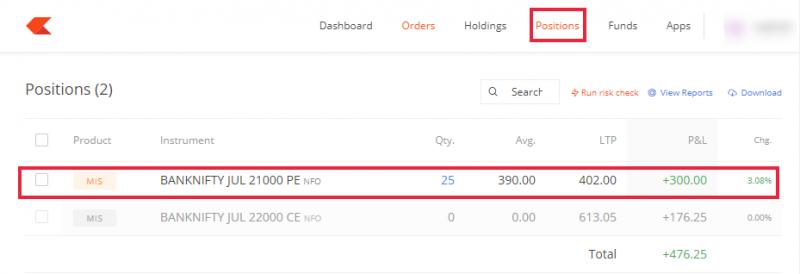
Option Trading Tips in India
If you are looking for tips to trade a few options and double your money then you are inviting trouble. Even the professional options traders find it difficult to close all the trades in profit.
Below are the option trading tips that will help you manage risk better and trade confidently.
#1. Keep Target Price in Mind
Options are risky if you do not have a target profit or loss price before you trade. You need to have a defined exit price even when a trade is in profit.
Remember you need to choose your upside exit point and downside exit point in advance.
#2. Cut Losses When Needed
Close the existing trade and cut your losses if the position is running in loss. Do not try to add a position to average because it may work against you.
Rather cut loss and think afresh to find a different trading opportunity.
#3. Choose the Most Liquid Option Contract
The illiquid option contracts have wide spreads that can lure you into trading. But it can be a trap when you are not able to close your position due to insufficient buyers or sellers.
Always trade options that are liquid and you have enough opportunities to buy/sell at any point in time.
#4. Allocate 2% to 5% for a Single Trade
Options trading involves risk and various factors affect options and the underlying assets like global news, political events and world economic situation.
You may not know when your position can turn bad. So it is prudent that you do not place all your capital in a single trade. Instead, you can allocate 2% to 5% of your capital in a single trade. This will contain your risk and help to trade for the next time.
Also, you need to trade by placing a stop loss whenever you trade-in options contracts which will restrict your potential losses by closing the loss position immediately.
For example, if you have a long position in a Bank Nifty Call at Rs. 700, then placing a stop loss at Rs. 680 will close the position in case the price falls. You will book a loss of Rs. 20 per quantity (Bank Nifty is traded in 25 underlying quantities) i.e. Rs. 20 x 25 quantity = Rs. 500 loss.
Placing stop loss will prevent the chances of bigger losses if the prices fall steeply to Rs. 650 or more.
#5. Capture Small Moves
Instead of capturing a large price movement that may or may not happen, you need to capture small price movements and trade frequently.
This will ensure that you have cash flows from more number of winning trades.
Final Words
Options trading has the potential to generate multifold returns if practiced correctly. Options trading is a full-time activity that allows you to have an additional source of income.
You can use options trading as a means to diversify your trading portfolio. But you need to have a clear strategy before you trade and have a disciplined approach while trading.